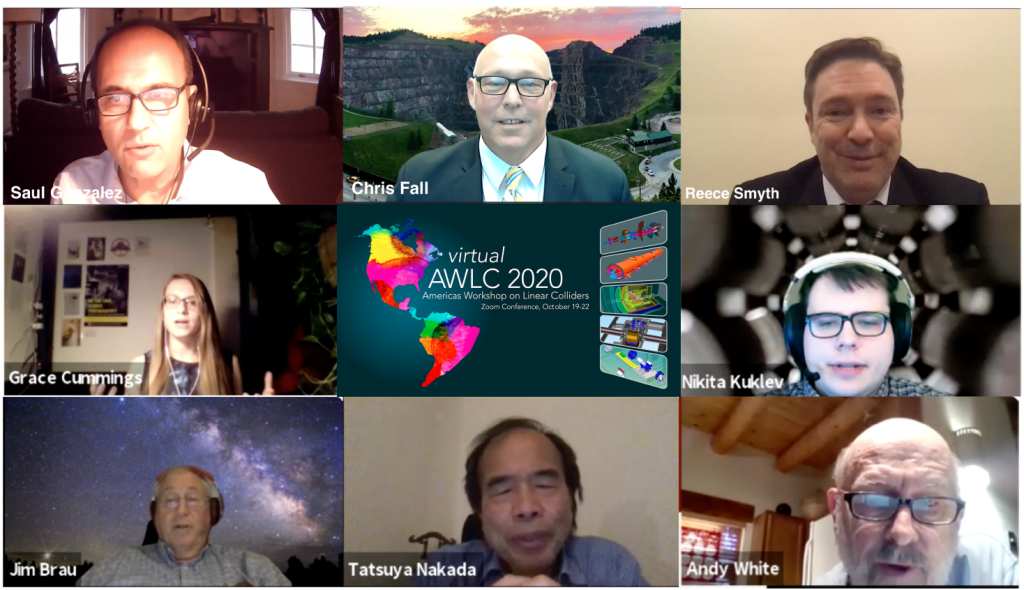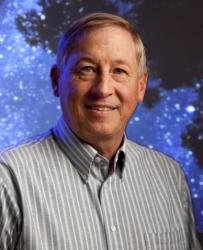
More than 500 attendees gathered virtually for the Americas Workshop on Linear Colliders in October.
From 19 to 22 October, the global community gathered virtually for the Americas Workshop on Linear Colliders (AWLC2020), focused on the International Linear Collider (ILC). More than 500 attendees registered for the programme of talks and discussions on the status of the project now that the International Development Team (IDT) formed by International Committee for Future Accelerator (ICFA) has begun its effort to prepare the path for an ILC pre-Lab envisioned to be started in 2022.
The four-day programme of plenary sessions began with a welcome from SLAC Director Chi-Chang Kao. The opening plenary also included an overview of the physics of the ILC by Nathaniel Craig. He reminded the participants of the questions the ILC precision physics programme can address:
- Is the Higgs elementary or composite?
- Does the Higgs interact with itself?
- Does it mediate a Yukawa force?
- Why is electroweak symmetry broken?
- How is electroweak symmetry broken?
He argued the ILC can uniquely provide the answers.
Following this motivational summary, the first day continued with talks by IDT leaders Tatsuya Nakada (chair), Andy Lankford (Americas representative), and Steinar Stapnes (European representative), and a report on the KEK perspective by Director General Masanori Yamauchi. Tatsuya Nakada described the goals of the IDT and the timeline foreseen for the pre-Lab and construction start, as well as the IDT thinking on the physics and detector steps that might be taken up to the start of the ILC Laboratory. Andy Lankford described planning for ILC pre-Lab activities in the US. Steinar Stapnes gave an overview of European planning for participation in the ILC pre-Lab. Masanori Yamauchi reported on R&D at KEK and political progress in Japan, emphasising the importance of recent positive statements on behalf of the US government. Michael Peskin presented an overview on the Snowmass planning process and the upcoming DOE/NSF P5 process in the US. Planning statuses in Canada and Latin America were described by Alain Bellerive and Maria Losada. The programme of the first day set the stage for the presentation and discussion of details that were coming in days two, three and four.
Nathaniel Craig’s stimulating introductory talk on Monday led into the morning physics parallel sessions covering the possibility of dark sector particles at the ILC, including their discovery in collider and fixed-target modes, several talks on precision calculations, and a tutorial on physics and detector simulations.
The status of the ILC accelerator design and development of its components was presented in a series of parallel meetings and in a plenary session on the second day of the conference. Shin-ichiro Michizono opened the Tuesday plenary session with an overview of the various systems of 250-gigaelectronvolt ILC, emphasising the maturity of the design, while indicating significant progress in achieving cost reduction and technical goals such as higher accelerating gradients. New treatments of the superconducting cavities have been shown to lead to gradients as high as 50 megavolts per meter while maintaining a high quality factor. In other areas such as the positron source and the beam dump, further design and development is needed.
In preparation for the pre-laboratory phase, Working Group 2 of the IDT has been organised into four subgroups: Superconducting RF, Damping Rings/Beam Delivery/Beam Dump, Sources, and Civil Engineering. During the pre-laboratory phase, these subgroups will be the basis for the technical preparation, final technical design, preparation and planning of deliverables, and specification of civil engineering and infrastructure designs. Reports on civil engineering (Nobuhiro Terunuma, KEK), European SRF activities (Olivier Napoly, CEA), Americas SRF activities (Sam Posen, Fermilab), LCLS-II (Marc Ross, SLAC), and Potential Canadian Contributions to the ILC accelerator (Oliver Kester, TRIUMF) completed the Tuesday afternoon plenary with details on activities to develop essential elements of the ILC.
Parallel accelerator sessions on Tuesday, Wednesday and Thursday mornings saw preliminary discussions of candidate countries and laboratories interested in providing effort for the ILC technical preparation. In particular, there is considerable related activity in all regions on superconducting RF cavity and cryomodule production for a wide variety of applications, giving a very positive outlook for future ILC production capabilities.
On Wednesday, a series of plenary talks on detector technologies was introduced by Markus Klute (Massachusetts Institute of Technology), who reviewed the ILC experimental environment, backgrounds, and resulting requirements on detectors. The two existing detector designs — ILD and SiD — were introduced and their performances reviewed. There then followed talks covering options for tracking (Jochen Kaminski, University of Bonn, on the time projection chamber and Caterina Vernieri and Michael Kagan, SLAC, on silicon), calorimetry (Francois Corriveau, McGill University, on particle flow and Sarah Eno, University of Maryland, on dual readout), forward detectors (Itamar Levy, Tel Aviv University), and software and computing (Jan Strube, Pacific Northwest National Laboratory and University of Oregon). Each talk noted the technology requirements and, particularly, the opportunities that exist for new ideas, new technologies, and alternative approaches.
The Wednesday detector plenary session ended with a lively panel discussion on early career opportunities in accelerator, physics and detectors for the ILC. A number of young colleagues from the Snowmass 2021 early-career community were invited to present their questions and concerns. Discussions covered job prospects, ways to engage in ILC studies, agency support, and long-term career paths. It was commonly expressed and agreed that involvement of young colleagues is a critical part of developing the ILC community, and forthcoming support will be the means to begin this process.
Following three days full of informative and motivational talks on all aspects of the ILC, the Thursday plenary began with a comprehensive talk by IDT Working Group 3 Chair (physics and detectors) Hitoshi Murayama on the physics opportunities of the ILC. He reviewed the primary initial physics motivation of the ILC aimed at precision measurements of the Higgs boson. He also reminded attendees of the potential for this programme to produce key indicators of the path to understanding the Higgs boson, amplifying points that Nathaniel Craig made on Monday. He also addressed broader potential for the project, such as dark sector exploration possible with fixed-target and beam dump experiments that need study.
The Thursday programme included an informative discussion, led by Frank Simon, Max-Planck-Institute for Physics, on the time required for detectors, including the preparation of the final R&D and engineering that is necessary before construction can begin. As was emphasised during this discussion, the detectors must find resources to keep pace with the accelerator.
An important element of the AWLC2020 programme was the three talks by US government representatives, Director Chris Fall (U.S. Department of Energy, Office of Science), Saul Gonzalez (National Science Foundation) and Reece Smyth (U.S. Department of State). Each expressed the interest of their offices in collaboration with Japan on the ILC and delivered important guidance on the framework for such collaboration. Next, Paul Grannis, State University of New York, led a distinguished panel that discussed many aspects of participation by the Americas in the ILC. The panel included Jim Siegrist (U.S. Department of Energy), Nigel Lockyer (Fermilab), JoAnne Hewett (SLAC), Stuart Henderson (Jefferson National Accelerator Facility), Dmitri Denisov (Brookhaven National Laboratory), Andy Lankford (IDT), Hitoshi Murayama (IDT), Alain Bellerive (Carleton), and Andy White (University of Texas, Arlington). The panel responded to questions posed by Paul on the level of US participation, the strategy for detector execution, areas of potential US contribution, challenges for the IDT, possibility for new funding (bump) in the US budget, lessons from Large Hadron Collider participation, engagement of Canada and Latin America, motivating young scientists, and impact of ILC on Future Circular Collider involvement.
The workshop ended with a talk by ICFA chair Geoffrey Taylor (University of Melbourne). Geoff reviewed the path that has brought us to this critical moment, from the work of the Global Design Effort, the Linear Collider Collaboration, and now the International Development Team, which is on the threshold of establishing the pre-Lab at KEK. Emphasising the global nature of our field, he reminded us why now is finally the right time for the ILC, realising the long anticipation for the facility that time and again has been recognised by the worldwide community as essential for progress in particle physics.
The execution of the programme was possible only with the support of SLAC, including the excellent assistance of Glenna Paige and the local committee chair, Michael Peskin. Planning for the meeting benefitted from excellent Program and International Advisory Committees. All of the plenary and many of the parallel sessions were recorded and are accessible at the workshop webpage.
The workshop provided an excellent overview, as well as introduction, to the importance of the ILC and the opportunities to contribute to its realisation. The community came away with a renewed enthusiasm for moving towards the realisation of the ILC, beginning with the pre-Lab phase.


Recent Comments